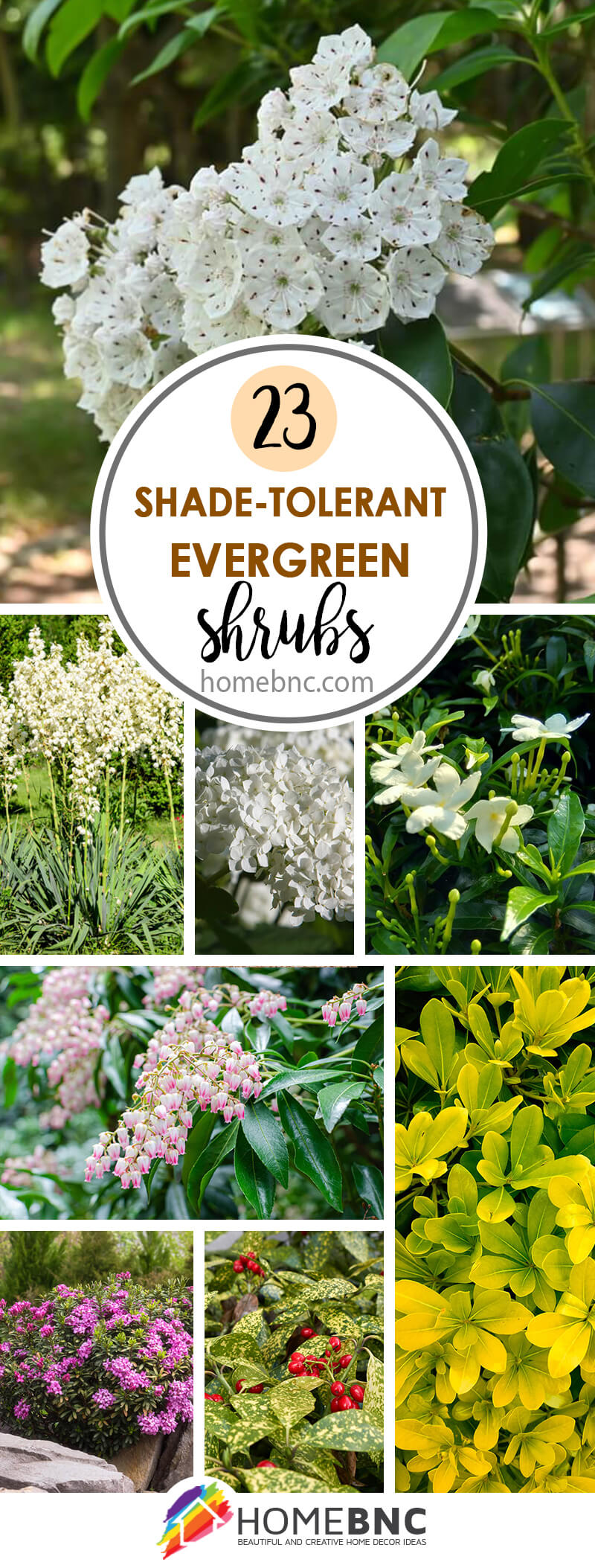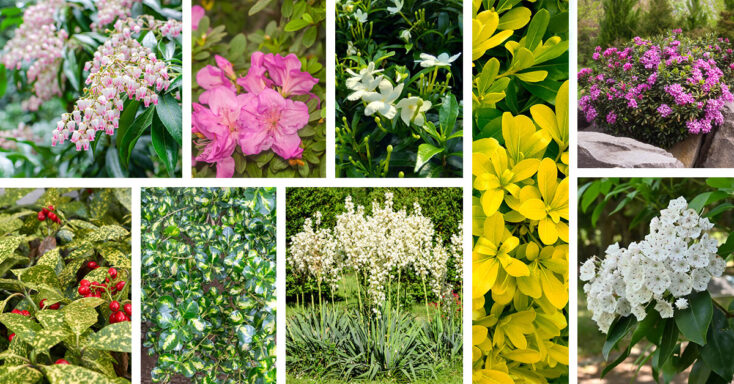You might look at your garden and think that nothing will ever grow under the shade of your trees, but I am here to tell you that there are plenty of shade-tolerant evergreen shrubs that will flourish in your garden.
Not only will they fill up the space and make your visitors jealous, but they will remain beautiful all year round, making you forget that winter is even a thing! Let’s take a look at both flowering and non-flowering varieties, as well as ones that will add interesting textures and extra character to your garden.
Key takeaways
There are many different shade-tolerant evergreen shrubs that will happily grow in the shady spots of your garden. As you read through our list, you’ll be able to determine which ones will work best for your USDA zone and the amount of shade you have in your garden. The most important takeaways are listed below:
- These types of shrubs are most common in Northern temperate regions.
- The average height of the shrubs is 6-12 feet.
- You can add a pop of color to your garden as many varieties can flower.
- Most shrubs do need occasional pruning to stay on the smaller side.
23 Enchanting Shade-Tolerant Evergreen Shrubs that will Make You Forget Its Winter
1. Wintercreeper (Euonymus fortunei)

If you are a fan of variegated foliage, this plant is perfect for your garden. The Euonymus family consists of over 130 species of shrub, generally grown for their beautiful foliage. The Wintercreeper is a fast-growing evergreen plant that can be grown as a sprawling shrub. Chances are you have seen this popular shrub before! It has beautiful green leaves with a stark white border. It can grow between 12-24 inches tall and can survive in partial shade as well as full shade areas in USDA zone 5 – 8. Before getting your hands on this plant, make sure it is not considered invasive in your area.
2. Mapleleaf Viburnum (Viburnum Acerifolium)
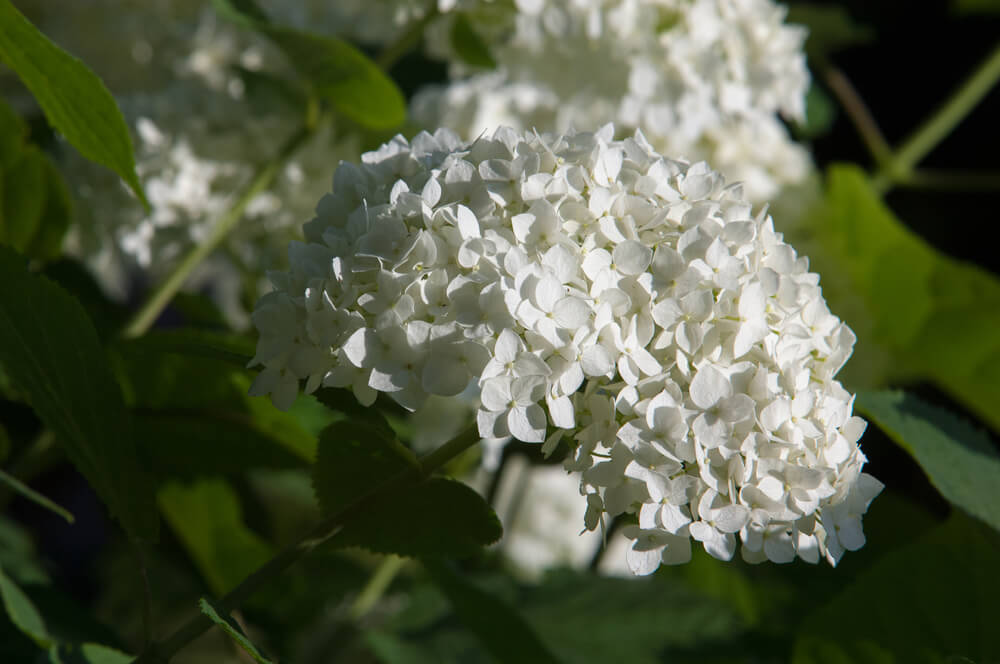
This plant is for the autumn color lovers! The Mapleleaf Viburnum is native to eastern North America. The leaves resemble small maple tree leaves and produce fragrant, attractive white flowers and blue-ish berries. In the fall, the colors of the leaves can range from deep purple to creamy pink. This shrub is drought tolerant which means it can be grown in most USDA zones and thrives in partial to full shade. It can grow up to 6 feet tall and 4 feet wide, so some pruning may be necessary. Although it is deer resistant, it can attract bird life in autumn when the fruits begin to appear.
3. Common Boxwood (Buxus Sempervirens)

The Boxwood is an interesting plant as it is one of the oldest known garden plants, dating back to 4000 BC. They have a dense growth habit with bright green, oval-shaped leaves and produce small, greenish-yellow flowers in spring. They are low maintenance but can get quite large if they are not pruned. They grow well in partial to dappled shade and are both deer and rabbit resistant. They are suited for USDA zone 5-9 and can reach up to 30 feet in height and 15 feet wide, so they can make brilliant hedges, or be shaped into any design you may want for your garden!
4. Adam’s Needle (Yucca filamentosa)

If you are looking to add some texture to your garden, we have the perfect plant for you. Adam’s Needle is aptly named for its long, sharp leaves. This plant makes quite a statement with a flower spike that can reach up to 15 feet tall, covered in white bell-shaped flowers. On average, the plant grows 3 feet high and 3 feet wide in USDA zone 4-10. Some varieties are variegated, with stark yellow stripes along the leaves. This is a deer and drought-resistant, hardy plant that can grow in any environment including full shade, however, they may not produce flowers. But that’s okay! These plants have such interesting foliage that it will make up for the lack of flowers.
5. Rosemary (Salvia rosmarinus)

Most people use Rosemary in their everyday cooking, but few know that it can be grown as a beautiful evergreen shrub. It has small deep green leaves with white undersides. Not only is it fragrant and useful in your home, but it also grows exquisite purple, blue, or white flowers that bees and butterflies adore. It grows up to 6 feet high and 4 feet wide, so some pruning may be necessary to keep it small. Contrary to popular belief, it can tolerate partial shade in USDA zone 8-9 and can add interesting texture to your garden.
6. Canada Yew (Taxus canadensis)
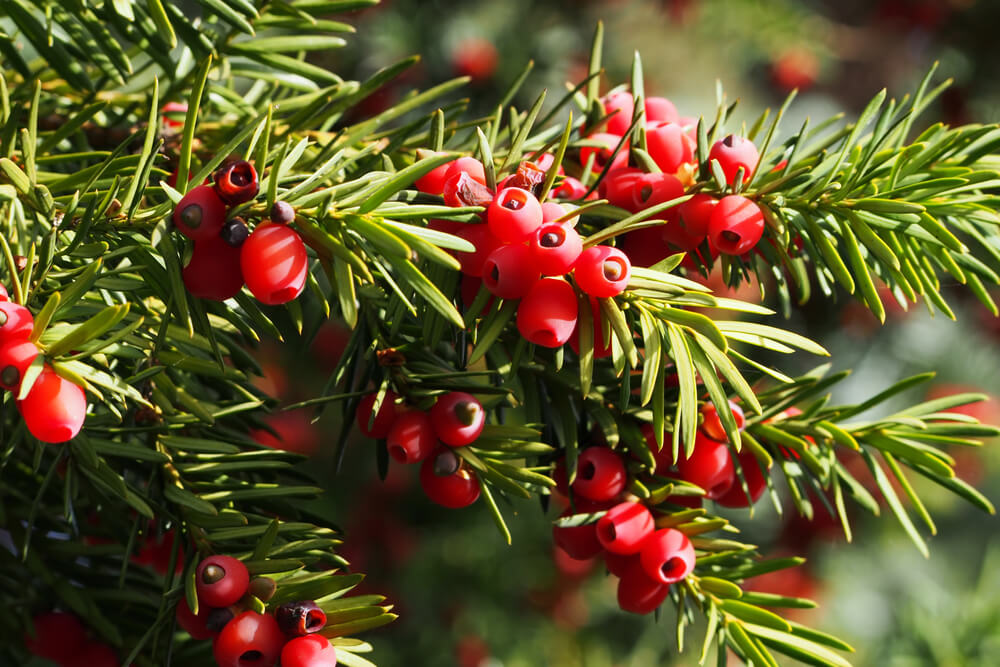
If you’re looking for a plant that prefers moist soil, this one might be perfect for you. Native to central and eastern North America, the Canada Yew is a low, straggling conifer that grows in both partial and full shade. It grows up to 6 feet high and 12 feet wide and has flat, needle-like leaves that are dark green, with pale green undersides that get a reddish tint during winter. This plant has beautiful red berry-like fruits that appears in early fall. It grows well in USDA zone 2-6 and can even be used to stabilize soil along your pond. It has quite a slow growth rate, so managing this plant is easy!
7. Evergreen Azalea (Rhododendron indicum)

If you are looking to attract more bees and hummingbirds to your garden, the Evergreen Azalea is a wonderful flowering shrub that comes in a variety of colors. This broadleaf shrub is not only grown for its showy flowers that cover almost all of the plant during mid to late spring, but also for its oval-shaped leaves that turn deep red in winter. It can be grown in USDA zone 6-9 in partial shade and is most commonly planted in groups. This shrub reaches about 4 feet tall and 4 feet wide and can be pruned after it flowers if necessary.
8. Indian Hawthorn (Rhaphiolepis indica)
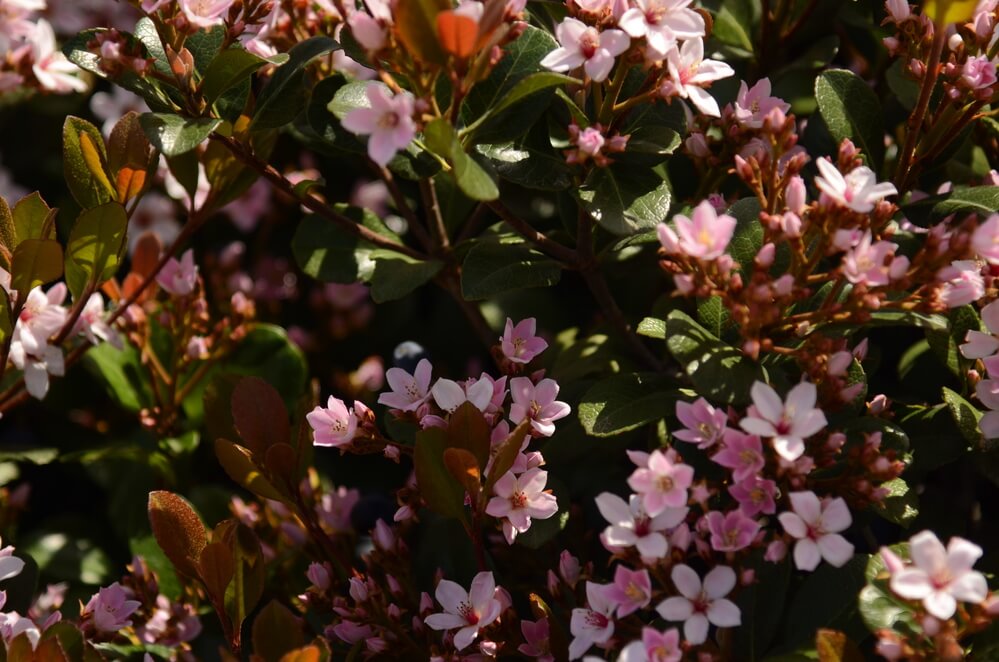
The Indian Hawthorn is a rounded, mounding shrub with a misleading name – it is actually native to southern China. It has slightly bronze leaves that mature to a deeper green and can grow clusters of either pink or white fragrant flowers. This shrub reaches about 4 feet tall and 4 feet wide but can be pruned if necessary after it flowers. In early winter, small blue-ish berries will appear that can attract wildlife to your garden. This plant can be grown in partial or dappled shade in USDA zone 8-11 and planted in groups to form beautiful, small hedges.
9. Wintergreen Barberry (Berberis julianae)
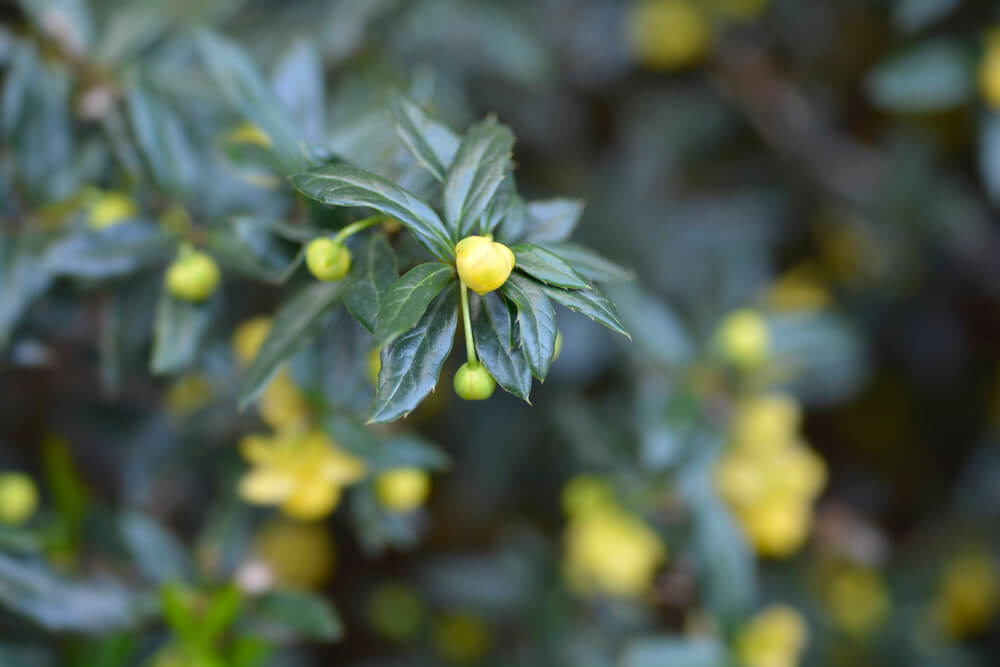
If you’re looking for a virtually indestructible plant, look no further. The Wintergreen Barberry is drought and shade-tolerant, deer-resistant, cold-hardy, and can withstand most soil types. It can be grown as a wind barrier as the thorny stems knit together as they grow. It has leathery green leaves that turn bright red during autumn which can add great color to your garden. In spring, bright yellow flowers appear that turn into blue-ish berries which attract birds and bees. They do well in USDA zone 6-9 and can reach 10 feet tall and 8 feet wide.
10. European Holly (Ilex aquifolium)
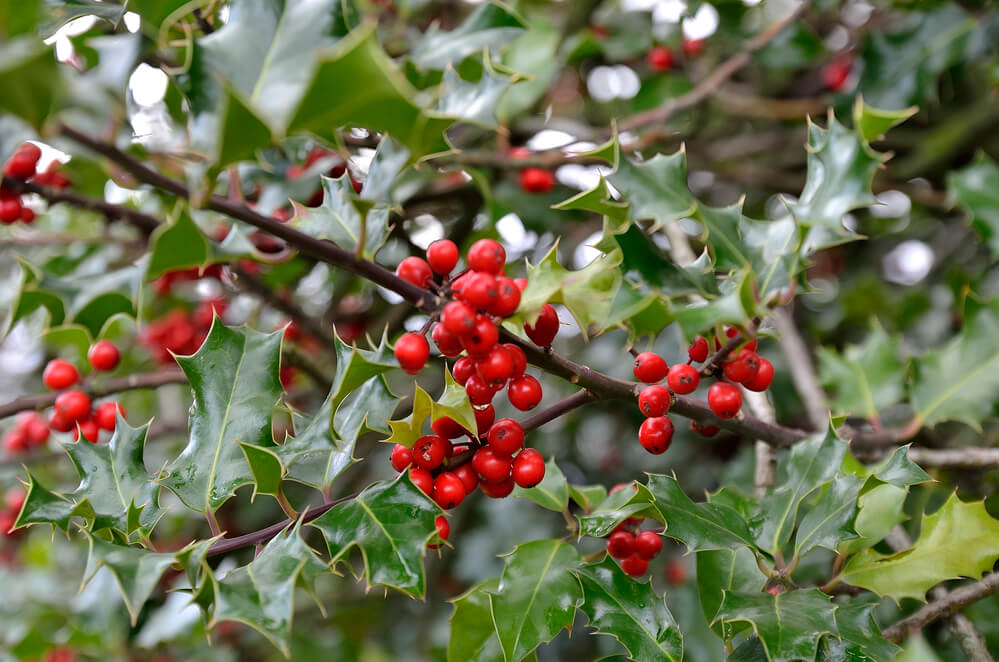
The European Holly is not only one of the most popular symbols of Christmas, but it is also a large evergreen shrub that is tolerant to partial or dappled shade. It is a slow-growing plant that can reach up to 60 feet tall, so pruning will be required to keep its shrub-like size. It can also be grown as a hedge suited to privacy. The glossy, leathery leaves have spiny teeth and when the fragrant white flowers are pollinated by bees, they form the iconic red holly berries. This plant grows in USDA zone 6-8 but is considered invasive in California, Alaska, and Oregon.
11. Cape Jasmin (Gardenia jasminoides)
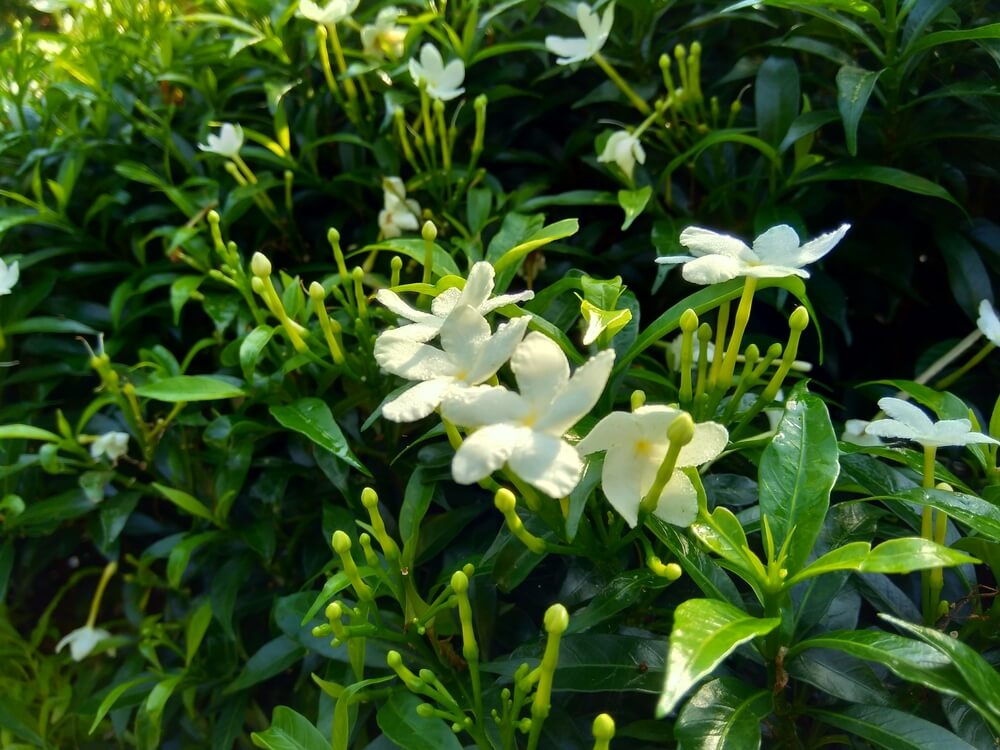
You may know the Cape Jasmine as an elegant flower found in wedding bouquets and prized flower arrangements, but did you know that it is also an evergreen shrub that can be grown in partial shade? What makes this plant unique is that it will produce fragrant flowers over a particularly long season. It has shiny dark green leaves and can be grown in pots or directly in the ground. They grow to around 2 feet high and 3 feet wide but you can prune them in spring to maintain their shape. Cape Jasmine grows in USDA zone 8-11.
12. Mirror Bush (Coprosma repens)
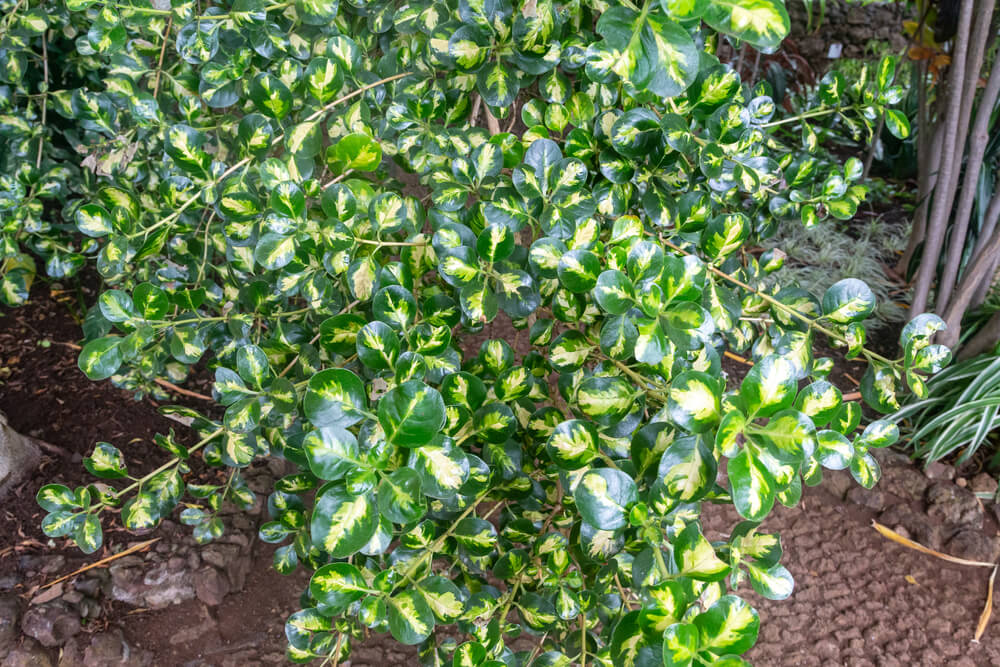
The Mirror Bush aptly gets its name from its glossy, leathery rounded leaves. They are a great screening shrub that is dense, compact and fast-growing. They are drought-tolerant, pest and disease resistant, and grow well in coastal areas. If you’re looking for a pop of color, the variegated varieties can add an interesting element to your garden, appearing in shades of yellow, orange, or even red. This shrub grows well in partial – full shade and can reach up to 6 feet high and 6 feet wide in USDA zone 9-11.
13. Mountain Laurel (Kalmia latifolia)

Mountain laurel is a great addition to any garden because it tolerates a wide range of light conditions, and can even thrive in full shade. It is native to North America and known for its showy clusters of pink, purple, or white flowers. This shrub is a slow grower that can reach up to 15 feet tall and can serve as a great hedge for privacy. It is part of the blueberry family and grows in USDA zone 4-9. But be careful of planting this shrub if you have cats or dogs as it is toxic to them.
14. Japanese Camellia (Camellia japonica)

You might recognize Japanese Camellia for its showy rose-like flowers that come in shades of pink and red, often appearing in front gardens for a pop of color during winter. It is a shade-loving shrub that attracts bees and birds to your garden during the long flowering season which is from October to March. It is a slow-growing plant, reaching up to 15 feet tall and 15 feet wide. When not in flower, the leathery, deep green, glossy leaves add beautiful texture to your garden. The Japanese Camelia grows in USDA zone 7-9 and will need to be monitored for pests.
15. Isu Tree (Distylium racemosum)
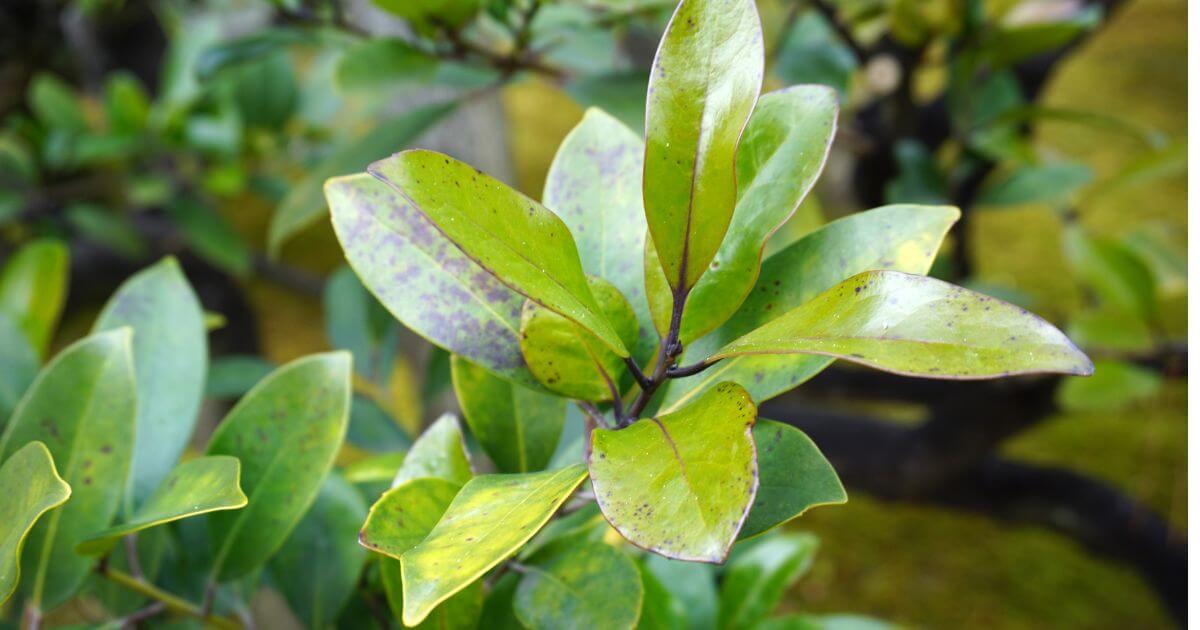
The Isu Tree is an elegant shrub that is part of the witch hazel family. Native to Japan, this plant was traditionally grown for its dark, hard wood but it can be grown as a partial shade-loving shrub border. In early spring, small clusters of red flowers appear which contrast beautifully with the plant’s glossy, bright green leaves. This plant is disease and pests resistant, drought-tolerant, and slow growing, making it easy to maintain. It can grow up to 10 feet tall and 8 feet wide in USDA zone 7-9.
16. Heavenly Bamboo (Nadina domestica)
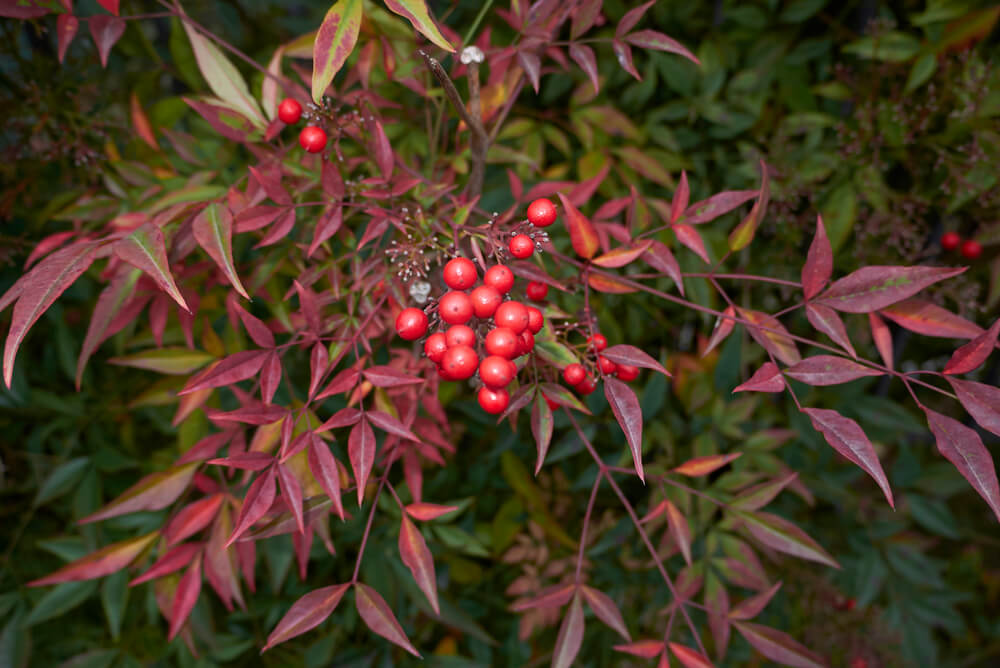
If you are a fan of colorful foliage, Heavenly Bamboo will blow you away with leaves that change color from deep green to yellow, to deep red with the seasons. It has cane-like growth and produces clusters of white flowers that turn into red berries that can last throughout winter. But beware – this plant is considered invasive in some states due to its ability to reseed itself and send up multiple suckers, and can be toxic to pets and small children. It grows in full shade and is drought tolerant, and can grow up to 8 feet tall and 4 feet wide in USDA zone 6-10.
17. Spotted Laurel (Aucuba japonica)

If you’re looking to add some unique foliage to the shady spots in your garden, Spotted Laurel is exactly what you might be looking for. It grows deep green leaves that are covered in yellow spots and showy red fruit appears in winter. It can be grown in containers or directly into the ground in partial to deeply shaded areas. Native to Japan, Spotted Laurel has adapted well to the North Carolina environment and can tolerate poor air and soil conditions. This plant can reach 10 feet in height and 6 feet wide and can be grown in USDA zone 7-9.
18. Japanese Holly (Ilex crenata)
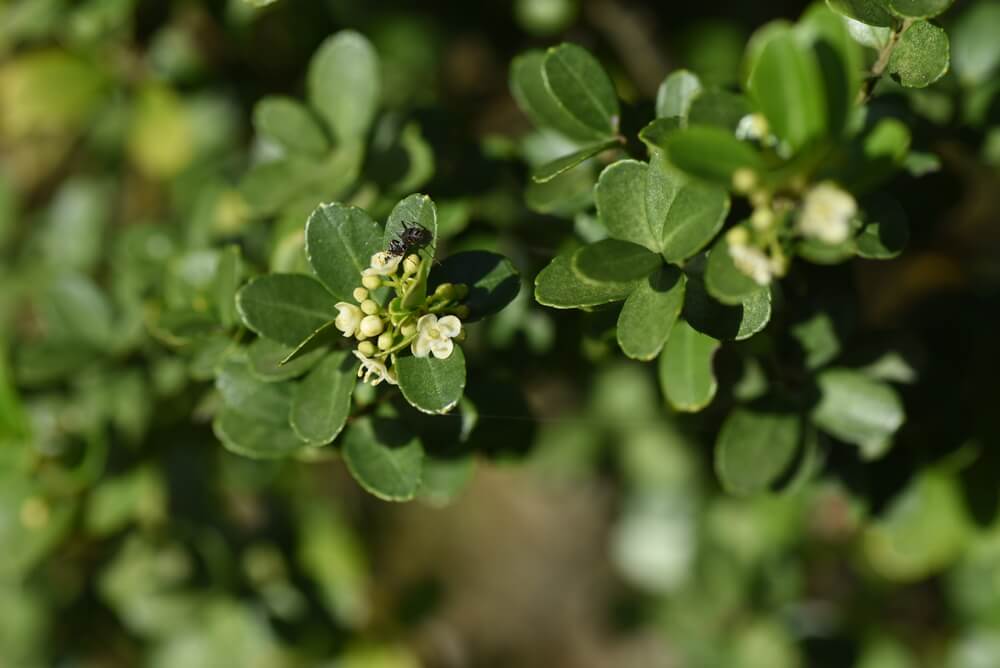
Japanese Holly has beautiful small leaves and clusters of white flowers that can add an interesting textural element to your garden. It prefers partial to dappled shade and is commonly used in topiaries meaning it can be pruned and shaped to nearly any form you’d like! It is well suited in small spaces, or can be planted together to form a short hedge. Japanese Holly can grow up to 10 feet fall, but also comes in a compact variety that reaches 3 feet tall. It is suited for USDA zone 5-8 and is drought tolerant.
19. Mock orange (Pittosporum tobira)
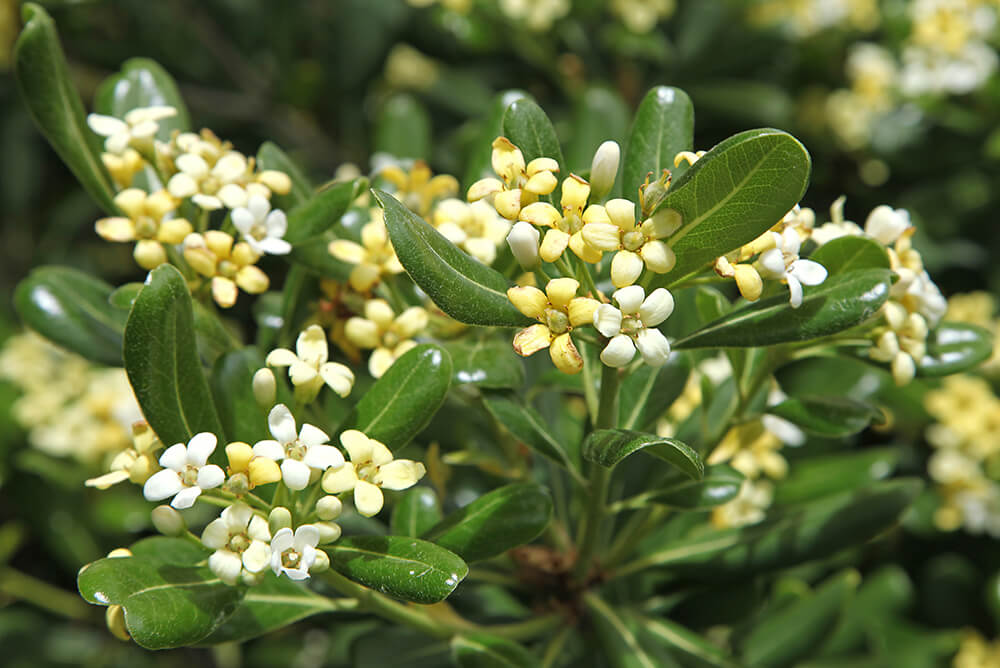
The Mock Orange gets its name from its small white fragrant flowers that cover the plant in spring. The flowers smell exactly like orange blossoms! It can have variegated leaves that add a pop of color to your landscape or be completely green. They prefer partial shade, and can quickly grow up to 4 feet tall and 4 feet wide. This plant can be grown as a screen, or a hedge, and may need regular pruning if you want to keep it on the smaller side. It grows in USDA zone 8-11, and is drought tolerant, but be warned that it is well-loved by deer.
20. Yellow Anise (Illicium parviflorum)
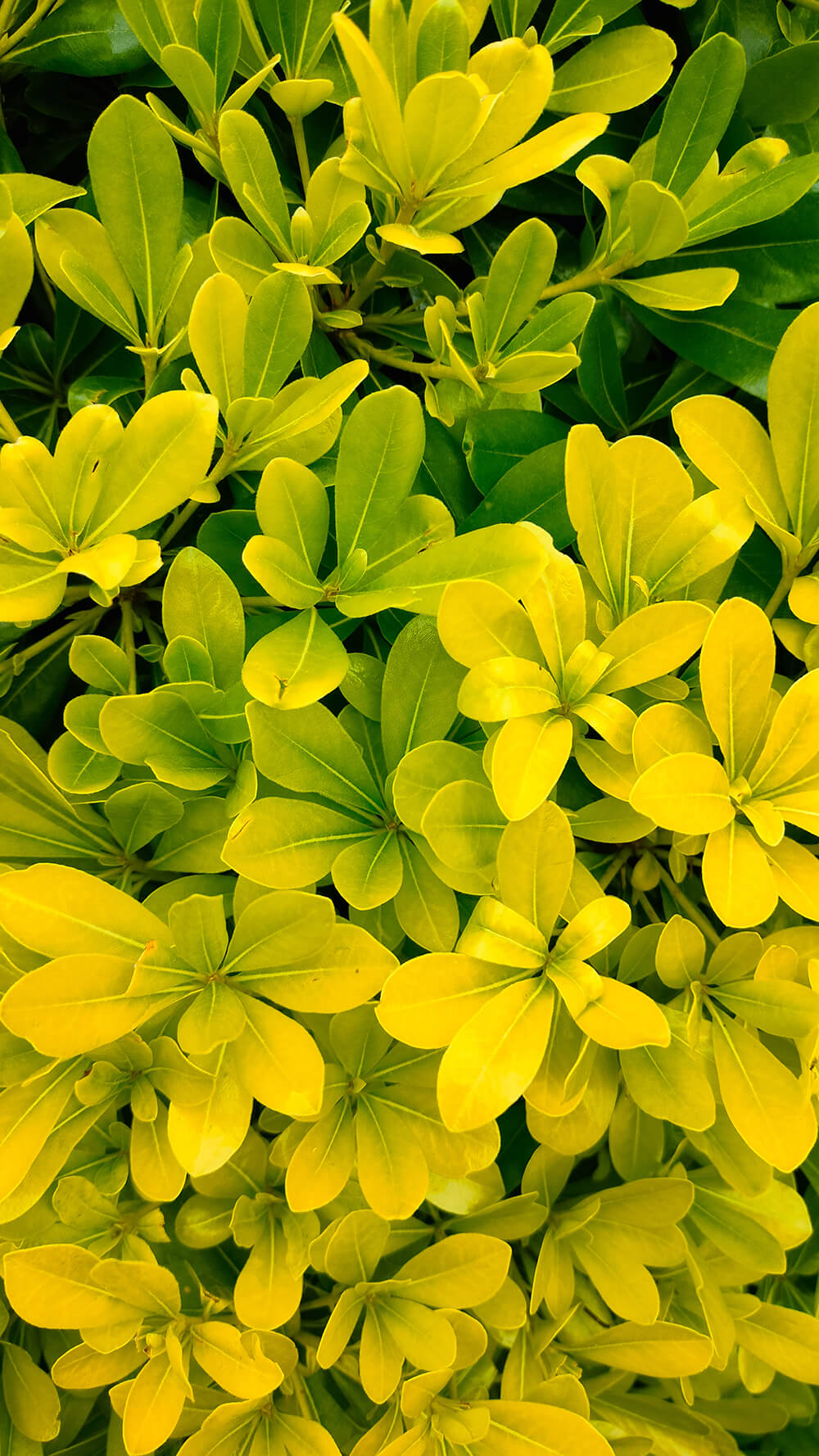
Another plant that thrives in full shade is Yellow Anise. Although this plant may look like the spice you have in your kitchen, the seeds of this plant are not edible. When new leaves appear, they are a bright yellowish green that matures to a more olive green, adding some brightness to your garden. This plant is native to southeastern areas of the United States and will grow in USDA zone 6-10. It can reach over 20 feet tall, so regular pruning may be needed. It is deer resistant and produces a licorice scent if the leaves are crushed.
21. Arborvitae (Thuja)
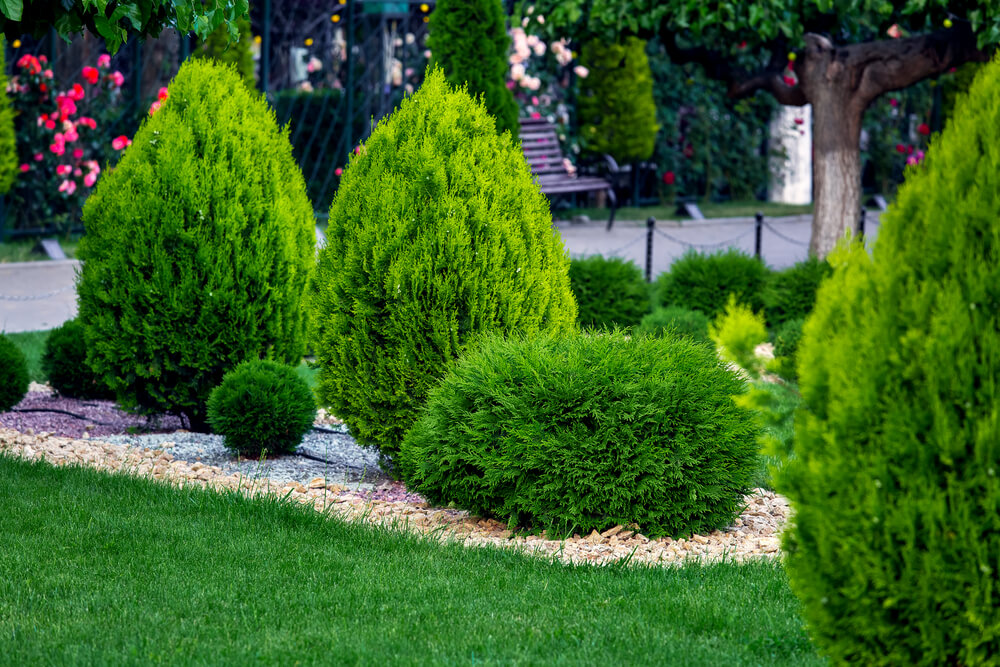
The Arborvitae is a common shade-tolerant shrub or tree that you have probably seen before. Native to North America, this plant is tolerant to most environments and grows in a conical shape. It is a dense shrub and can add a great textural element to your garden as it has scale-like leaves. They produce blue-ish fruits and omit an odor if the leaves are bruised. This plant grows well in partial shade and is drought-tolerant and deer resistant. It can reach up to 15 feet tall and grows in USDA zone 2-8.
22. Winter Daphne (Daphne odora)
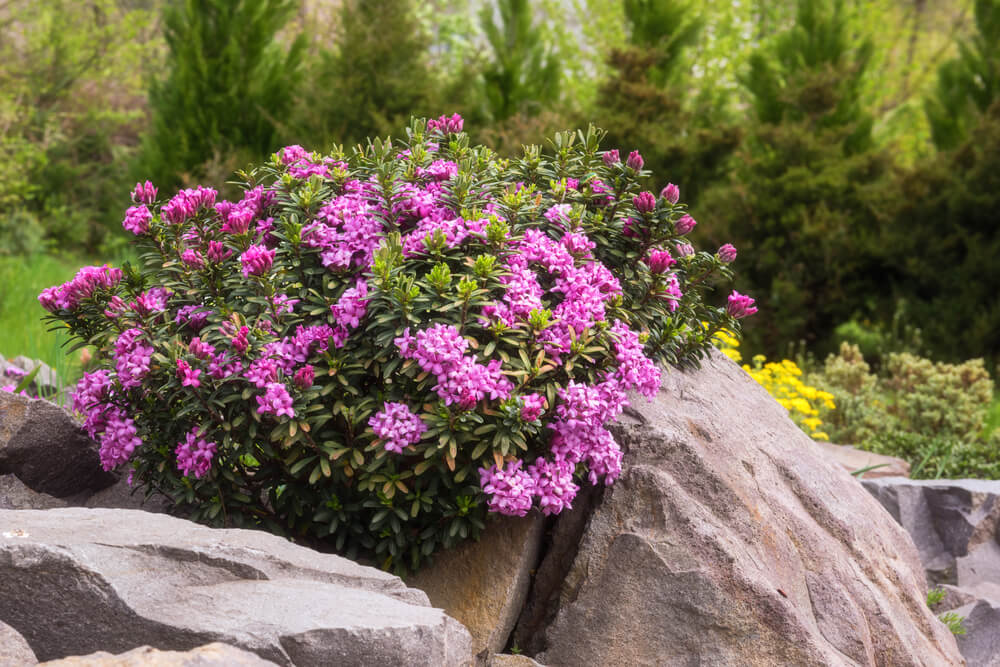
If you’re looking for a plant that will attract bees, butterflies, and moths to your garden, the Winter Daphne is for you. They grow well in partial shade and produce deeply fragrant flowers that can be pink, purple, or white. It is a densely branched plant that grows well in between rocks and when not in flower, it has beautiful shiny deep green leaves. It reaches about 6 feet in height and grows in USDA zone 7-9. But beware: this plant is poisonous if ingested and the sap can irritate your skin, so wear gloves when pruning this plant.
23. Japanese Pieris (Pieris japonica)
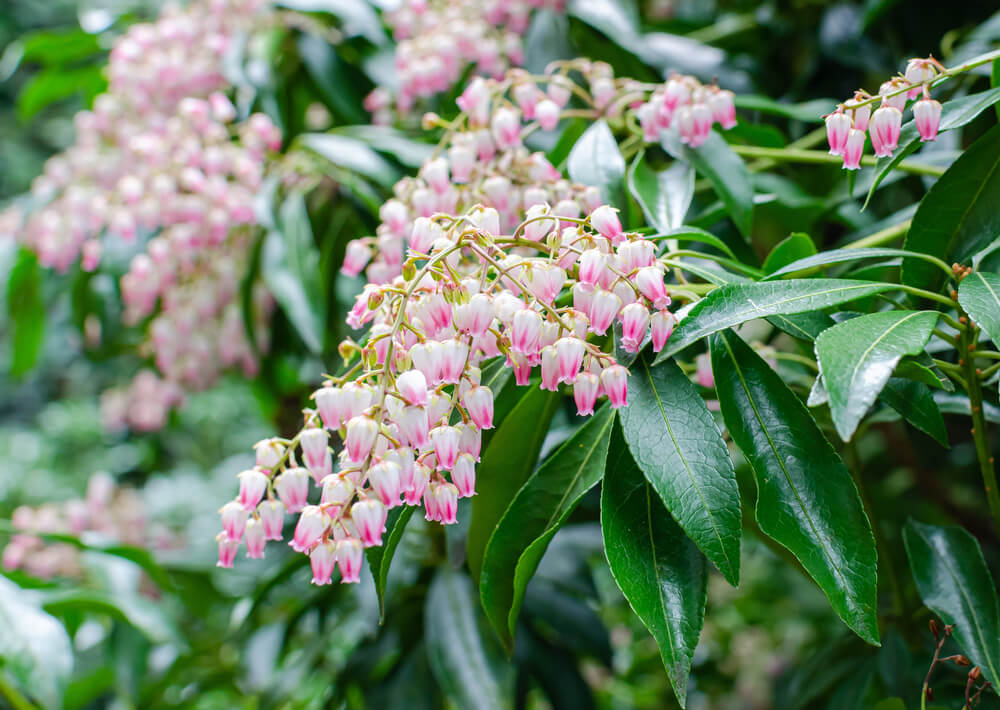
This bushy, rounded plant is a show-stopper. The leaves emerge deep bronze or purple, adding beautiful color to your garden throughout all four seasons. In spring, cascading clusters of white blooms that resemble Lily of the Valley flowers produce a strong scent that can waft into your home. It is a slow-growing shrub that can reach 15 feet tall and 8 feet wide. This plant can tolerate partial to full shade and grows in USDA zone 5-8. It is deer resistant, can be grown as a hedge if planted closely together, and prefers moist soil.
23 Fantastic Shade-Tolerant Evergreen Shrubs For Where The Sun Doesn’t Shine
Although you may have to give up on the idea of having tropical plants, roses, or other sun-loving plants in your garden, there are plenty of beautiful and unique evergreen plant options for your shaded areas. Some of the ones we enjoy the most are Rhododendrons which come in a variety of colors, and Mountain Laurel which can create beautiful hedges that are perfect for some extra privacy. Keep in mind that shade is seldom constant and you will need to observe how the light changes throughout your garden before you choose what to plant.
Frequently Asked Questions About Shade-Tolerant Evergreen Shrubs
Which are the best shade-tolerant evergreen shrubs for privacy?
You may be looking into shade-tolerant evergreen shrubs for a sense of privacy in your yard but are worried that nothing will grow. Luckily, there are a few plants that are perfectly suited to your needs. These include Mountain Laurel (Kalmia latifolia), European Holly (Ilex aquifolium), and Common Boxwood (Buxus Sempervirens).
What shrubs like full shade?
There is a misconception that plants need a lot of sunlight to grow well, but there are plenty of shrubs that will thrive in full shade, some of them will even flower! These include Wintercreeper (Euonymus fortunei), Mountain Laurel (Kalmia latifolia), Japanese Camellia (Camellia japonica), Spotted Laurel (Aucuba japonica), and Yellow Anise (Illicium parviflorum).
What evergreen plants grow well in the shade?
There are many evergreen plants that grow well in the shade, including all of the shrubs that are on our list. Other plants include trees such as the Strawberry Tree (Arbutus unedo), carpeting plants such as the Japanese Spurge (Pachysandra terminalis), and flowers such as the Lily of the Valley (Convallaria majalis).
Does a shade-tolerant deer-resistant evergreen shrub exist?
You will be pleased to know that there are many shade-tolerant deer-resistant shrubs including Rosemary (Salvia rosmarinus), Adam’s Needle (Yucca filamentosa), and Yellow Anise (Illicium parviflorum). The Common Boxwood (Buxus Sempervirens), however, is one of the most deer-tolerant evergreen shrubs and is commonly grown as a hedge.
